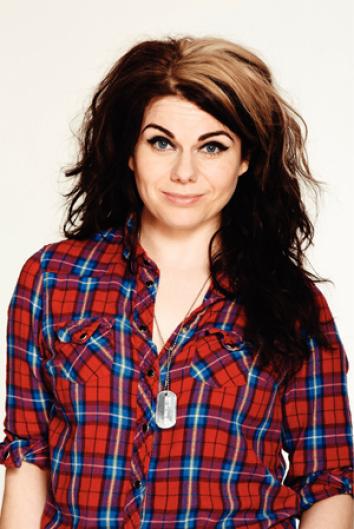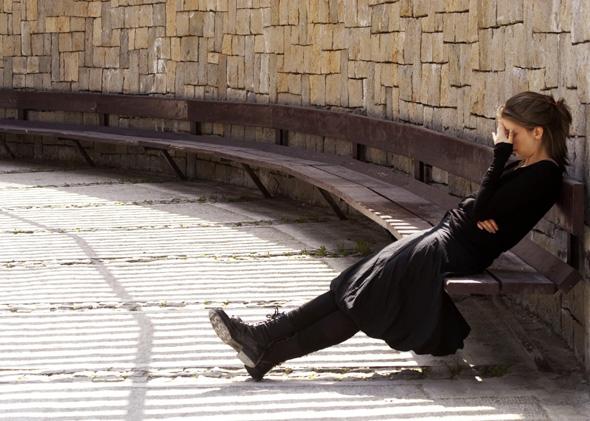In Moranthology, Caitlin Moran’s 2012 compendium of her decades of brash, personal columns for the British press, Moran jokes that as a teenage girl living in public housing in Wolverhampton, England, her career options were limited to “prostitution,” “working the checkout at the Gateway supermarket,” or “becoming a writer.” Moran chose door No. 3, of course, and in this month’s novel How to Build a Girl, she loans the line to protagonist Johanna Morrigan, a 14-year-old girl living in public housing in Wolverhampton, England. Johanna—a voracious reader and even more insatiable masturbator—is too poor for records and too young to fuck, so she learns what rock music sounds like and what semen tastes like via borrowed library magazines, then rebrands herself as the London party girl Dolly Wilde, cinches a job as a teen music journalist, and sets out to hear and taste for herself. “If I don’t keep this job,” Johanna tells her mother, “then my only future career options are working in Argos or being a prostitute.”
Moran, too, was a journalistic girl wonder, reviewing records for Melody Maker by 16 and installed as a Times columnist at 18. (The incessant masturbation, which Johanna accomplishes with the aid of hairbrush handles and mercifully phallic deodorant canisters, was also an early hobby of Moran’s.) Now 39, Moran is unleashing her accumulated wisdom on the world, and How to Build a Girl is the latest stage in her campaign to conquer every conceivable medium. In the past four years, she’s spun her life experiences into How to Be a Woman, her best-selling memoir and feminist polemic; the 2012 column anthology; Raised by Wolves, a sitcom based on her childhood relationship with her sister; tens of thousands of tweets, which British students study as a text in preparation for their A-level exams; and now, the roman a clef.
Moran insists that the novel is “all fictitious,” but Johanna’s details are barely shifted from Moran’s own, a kind of pig Latin applied to memoir. She’s swapped the surname “Moran” for “Morrigan,” traded a couple of words in the book title (“Be” for “Build,” “Woman” for “Girl”), and installed Johanna at Disc and Music Echo magazine. When Johanna arrives at the London D&ME offices for her first interview at 15, she steps into an “office built out of trousers, confidence, and testicles”; when the veteran rock critics offer her a job penning reviews of bands she’s never heard of, she responds in the least cool way possible: She quotes Annie and mimes washing the office walls. The anecdote is inspired by Moran’s own visit to the Observer offices at 15, and the telling is ripped nearly word-for-word from Moran’s Moranthology account.
When Johanna’s story does diverge from Moran’s, the edits serve to mold the protagonist into a more relatably awkward everygirl. At 13, Moran won 250 pounds in a youth writing contest for an essay called “Why I Like Books,” but Johanna nets the same sum by penning an endearingly horrendous poem about her best friend, her dog. (“We run in a pack of two/ You’ve seen me through the RUFF! And smooth.”) Moran published her novel The Chronicles of Narmo, itself a fictionalized account of her Wolverhampton upbringing, at 16; when Johanna toils on her own novel in the obscurity of her bedroom, it’s about a girl who mounts a dragon and travels through time, righting historical wrongs. (When she teaches Hitler the error of his ways, he weeps.) By age 14, Johanna is so unaware of her place in the world that she has never even thought to look in a mirror. Having imagined herself a posh waif, she discovers she’s a husky dork only after appearing on a local television program to discuss her award-winning canine poetry. She panics and performs an on-air Scooby Doo impression that derails her ascent as a celebrated wit and moors her again as a schoolyard laughingstock.

Photo by Mark Harrison
Johanna may fumble in projecting her vision to the world, but her internal monologue speaks with the steady wisdom and pointing wit of a certain world-famous 39-year-old humorist. Every humiliating teenage battle Johanna fights comes preloaded with the snarking retort of a grown woman who’s already won the war. As a 14-year-old virgin, Johanna yearns for a man to have “absolute, total sex with me, right in my sex places, in the most sexual way possible.” And when she finds herself squished up next to boys in a mosh pit, she thinks, “I am roughly 7 percent less virgin now!” These feel like moments that Moran not only lived as a girl, but has already relived as a woman—she’s plugged them into story arcs, polished the phrasing, delivered the jokes, and extracted the lessons. “Life basically divides into two parts,” Moran said in a BBC interview this year. “Things which are amazing at the time. And things which are awful at the time, which then turn into amazing anecdotes.” Johanna’s awful moments convert instantly to anecdotes, skipping over the sometimes painful process of finding her own voice. This is Moran on her dragon, traveling through time to whisper a one-line rejoinder to Johanna’s every slight. Awkward teenage girls everywhere might welcome the fantasy, but the reader feels robbed—we rarely get the gift of growing up alongside Johanna, because Moran is already fully formed.
Only when Johanna escapes Moran’s well-trodden Wolverhampton stomping grounds and emerges as London booze hound, sexual animal, and perpetual imposter Dolly Wilde does it begin to feel like Johanna and Moran are surveying the territory for the first time. As Johanna takes notes on “how to build a girl, and put her out in the world”—taking cues from female musicians and trial-and-error party antics—we take a delicious dive into the mechanics of what Gillian Flynn branded, in an aside in her novel Gone Girl, the “Cool Girl.” As Flynn put it:
Being the Cool Girl means I am a hot, brilliant, funny woman who adores football, poker, dirty jokes, and burping, who plays video games, drinks cheap beer, loves threesomes and anal sex, and jams hot dogs and hamburgers into her mouth like she’s hosting the world’s biggest culinary gang bang while somehow maintaining a size 2, because Cool Girls are above all hot. Hot and understanding.
Johanna learns to reshape herself in that image with every new record review she ships off to her male editor or crush she gets into bed, and the insights are hard-won. When she finally has sex, Johanna says, “I didn’t come, but when he came, I felt enormously … useful. Men need to come—and I had made it happen.” When she has more sex, she worries about being slapped with the label “massive slag,” so she proactively applies it to herself. And when she has even more, she wishes for “more sex. Better sex. Sex with more of me in it.” The thrill and letdown of becoming a guy’s girl reveals itself in Johanna’s summation of her job: “I get paid by the word, and it’s a thrill when that word is ‘cunt.’ ” There’s no need to spell out Moran’s all-knowing perspective here; the thrill is in watching Johanna discover the contradictions for herself in rollickingly raw detail. (Johanna realizes that she wants more “me” in sex after experiencing an obscenely large penis in her.) At book’s end, the voice of adult Johanna, or else modern-day Moran, swoops in to unleash her trademark wit on the subject of the dangers of building yourself from the outside in. This time, the joke feels earned.
—
How to Build a Girl, by Caitlin Moran. Harper Collins.
See all the pieces in this month’s Slate Book Review.
Sign up for the Slate Book Review monthly newsletter.
